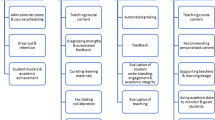Abstract
This paper starts from some observations about Presmeg’s paper ‘Mathematics education research embracing arts and sciences’ also published in this issue. The main topics discussed here are disciplinary boundaries, method and, briefly, certainty and trust. Specific interdisciplinary examples of work come from the history of mathematics (Diophantus’s Arithmetica), from linguistics (hedging, in relation to Toulmin’s argumentation scheme and Peirce’s notion of abduction) and from contemporary poetry and poetics.
Similar content being viewed by others
Notes
To make a start,
out of particulars
and make them general, rolling
up the sum, by defective means—
Sniffing the trees,
just another dog
among a lot of dogs.
(Williams 1946/1985, p. 259)
In his attempt to trace the origins and shifting meanings of this word, Tahta (2001) offered the following source notes:
Thus: mathematicize: (a) to consider or treat in a mathematical manner, (b) to reason mathematically; to make mathematical calculations. 1849: Froude, Nemesis 161—“The dry mathematicizing reason” 1885: Mrs H. Ward, Amiel's Journal (18 December 1859, l 131)—“his strength lies in mathematicizing morals”.
And: mathematize: 1719: Freethinker, no 117, p. 7… 1833: Newman, Letters (1891, l 365)… 1894: University Extension Journal 1 Oct 11/2 “The author has carefully avoided the error of needlessly mathematizing what can be better described in words”.
I am aware that it is a commonplace pedant’s remark to distinguish ‘method’ from ‘methodology’, where the latter word refers to a discipline like any other ‘-ology’, in this case the study of method. And a ‘methodologist’ (including Garfinkel’s self-delineation as an ‘ethnomethodologist’) is someone who practices that discipline. But while there were significant conceptual shifts when ‘geometry’ became ‘a geometry’ thereby allowing ‘geometries’ (likewise with algebra), permitting ‘methodology’ to stand for ‘method’ and then to morph into ‘methodologies’ worries away at me. And Presmeg’s phrase “a methodology of mixed methods” seemed both opaque and convoluted in the extreme.
When John (14:6) reports Jesus saying, “I am the way, the truth and the life”, ‘way’ is οδος in his original Greek. And οδος, like via in Latin and unlike dao in Chinese, is attached to a human being.
The metaphor of ‘gold standard’ research is so strange, in that the US going off the gold standard in 1934 is what is widely considered to have been a major contributor to the ending of the great Depression (though present circumstances transpiring as I write might surpass that, of course).
I took gentle exception to the marginalizing effect of Presmeg’s “even linguistics”.
References
Bruner, J. (1986). Actual minds, possible worlds. Cambridge, MA: Harvard University Press.
Channell, J. (1994). Vague language: Some vague expressions in English. Oxford: Oxford University Press.
Christianidis, J. (2007). The way of Diophantus: Some clarifications on Diophantus’ method of solution. Historia Mathematica, 34(3), 289–305.
Coomaraswamy, A. (1943/1956). Christian and Oriental philosophy of art. New York, NY: Dover [1943 title: Why Exhibit Works of Art?].
Csiszar, A. (2003). Stylizing rigor; or, why mathematicians write so well. Configurations, 11(2), 239–268.
Halliday, M. (1973). Explorations in the functions of language. London: Edward Arnold.
Halliday, M. (1978). Language as social semiotic. London: Edward Arnold.
Hyland, K. (1998). Hedging in scientific research articles. Philadelphia, PA: John Benjamins.
Hyland, K. (2000). Disciplinary discourses: Social interactions in academic writing. New York, NY: Longman.
Inglis, M., Mejia-Ramos, J., & Simpson, A. (2007). Modelling mathematical argumentation: The importance of qualification. Educational Studies in Mathematics, 66(1), 3–21.
Joseph, G. (1991). The crest of the peacock: Non-European roots of mathematics. London: Penguin Books.
Lakatos, I. (1976). Proofs and refutations: The logic of mathematical discovery. Cambridge: Cambridge University Press.
Lakoff, G. (1972). Hedges: a study in meaning criteria and the logic of fuzzy concepts. Chicago Linguistic Society Papers (pp. 183–228). Chicago, IL: Chicago Linguistic Society.
Morgan, C. (1996). “The language of mathematics”: Towards a critical analysis of mathematics texts. For the Learning of Mathematics, 16(3), 2–10.
Phillips, A. (1993). On kissing, tickling and being bored. Cambridge, MA: Harvard University Press.
Presmeg, N. (2009). Mathematics education research embracing arts and sciences. ZDM The International Journal on Mathematics Education (in this issue).
Prince, E., Frader, J., & Bosk, C. (1982). On hedging in physician–physician discourse. In Di Petro, R. (Ed.), Linguistics and the Professions (pp. 83–97). Norwood, NJ: Ablex.
Reid, C. (1970). Hilbert. New York, NY: Springer.
Rowland, T. (1995). Hedges in mathematics talk: Linguistic pointers to uncertainty. Educational Studies in Mathematics, 29(4), 327–353.
Rowland, T. (2000). The pragmatics of mathematics education: Vagueness in mathematics education. London: Falmer Press.
Sinclair, N. (2008). The teacher as midwife: what can mathematics education research learn from obstetrics? In de Freitas, E. & Nolan, K. (Eds.), Opening the research text: Critical insights and in(ter)ventions into mathematics education (pp. 33–40). New York, NY: Springer.
Sinclair, N., & Pimm, D. (2008). Surface signs of reasoning. Paper submitted to the Language and Mathematics group. CERME 6, Lyon, France.
Sinclair, N., Lee. K. & Strickland, S. (2008). Abductive inferences in mathematics thinking: Necessary risks. Educational Studies in Mathematics (under review).
Staats, S. (2008). Poetic lines in mathematics discourse: A method from linguistic anthropology. For the Learning of Mathematics, 28(2), 26–32.
Stoppard, T. (1972). Jumpers. London: Faber and Faber.
Tahta, D. (2001). Mathematisation. (http://mathforum.org/kb/thread.jspa?threadID=383280&messageID=1181751).
Wheeler, D. (1974). Mathematization. Notes of the Canadian Mathematical Congress, 7(2), 1–5.
Wheeler, D. (1978). Mathematization as a pedagogical tool. The Education of Mathematics Teachers (pp. 147–158). An ICMI/IDM symposium. Bielefeld: Institut für Didaktik der Mathematik, Universität Bielefeld.
Williams, W. (1985). Selected Poems. New York, NY: New Directions Books.
Yeats, W. (1918). Per amica silentia lunae. London: Macmillan and Co. Ltd.
Zwicky, J. (2006). Lyric, narrative, memory. In Finley, R. et al., A ragged pen: Essays on poetry & memory (pp. 87–105). Kentville, NS: Gaspereau Press.
Author information
Authors and Affiliations
Corresponding author
Rights and permissions
About this article
Cite this article
Pimm, D. Method, certainty and trust across disciplinary boundaries. ZDM Mathematics Education 41, 155–159 (2009). https://doi.org/10.1007/s11858-008-0164-2
Accepted:
Published:
Issue Date:
DOI: https://doi.org/10.1007/s11858-008-0164-2




